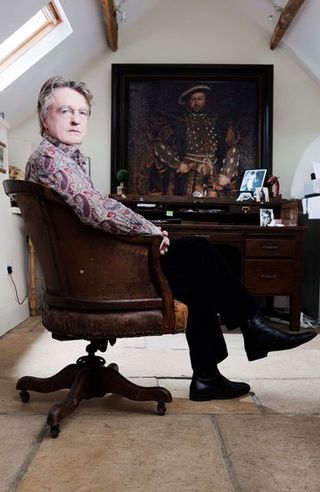Vikings Firmly In The Zeitgeist
Michael Hirst has sympathy for pagans, including eighth-century Vikings, and the fate their religion suffered at the hands of Christianity.
If that turns around the cliché of Norse raiders savaging Christian monasteries in Britain, well, that’s nothing new for the creator and writer of History’s hit series Vikings. After surpassing all other new cable series last year to average 4.3 million total viewers (2 million in the adults 25-54 bracket), the show returns for a 10-episode second season, set in A.D. 796, this coming Thursday, Feb. 27.

Season one was a lot more than swords, sails and a total absence of historically incorrect hornet helmets. It was a deep dive into Dark Ages Scandinavians’ family and religious lives, their technology and their feudal social structures.
Hirst told me a highlight of season two is the conflict between Viking religious beliefs and how “the triumph of Christianity meant the total demise and disappearance of pagan religion.” It’s personified by Athelstan (played by George Blagden), the monk who was taken prisoner by Viking leader Ragnar Lothbrok (Travis Fimmel) in season one and is now caught between the Saxon and Viking worlds and their gods. “It was a real issue for him, and was a real issue for a lot of people at the time,” Hirst said in a recent telephone interview from his home in, at that time, flood-soaked England.
He mentioned with pride that a Huffington Post review called Vikings the rare television show that takes religion and religious belief seriously. He also took note that "somehow, Vikings is in the Zeitgeist." A major new exhibition, "Viking," is about to open at the British Museum (through June 22) that includes a revelatory Viking ship dug up recently that could carry more than 100 warriors. Another Viking settlement has been found on the coast of Canada, he said, and Viking graves have been dug up in York, England, and of a Viking princess in Russia. "Somehow, the Vikings have come back to us," he said.
I might note here that a new Smithsonian Magazinearticle on the British Museum exhibit is headlined: "Revenge of the Vikings: After decades of scholarship that emphasized their kinder, gentler side, the bad boys of the North are back with a vengeance." History's Vikings has shown both elements all along.
Viewers this season also will see that Vikings, more than merely raiders, were settlers. One of Ragnar’s goals this season is to make a treaty with the English and build communities and farm, not just plunder. As Hirst notes, Vikings founded Dublin in Ireland and York, England, in addition to colonizing North America centuries before Columbus.
There is plenty of violence in season two, no mistake. “No one is denying that they were brutal and the world was brutal,” Hirst said. But bear in mind the tales of their bloodthirsty deeds were written about by the Christian monks who were their victims. And one could also say “they happened to be particularly brilliant fighters.”
We’ll see this season that, unlike in the West at that time, Viking women could divorce their husbands. (We already know Viking women could fight in battle, as shown by the fierce shield maiden Lagertha, played by Katheryn Winnick.)
Not to skip past season two, which Hirst notes has a heftier scale and bigger battles than the first go-round. “It felt like we’d gone up two notches,” was his reaction when he returned to the original village set (in Ireland) to see it had quadrupled in size.
But season three, which he’s writing now, would include one heck of a centerpiece for the historic Ragnar.
“It’s no secret that I want them to attack Paris, because Paris at that time was a very significant city,” the The Tudors writer creator said of the raid in 845 A.D. “The attack on Paris, there were over 100 Viking ships, and it’s a great story I want to tell.”
Vikings season two premieres Thursday at 10 p.m. ET/PT on History. Photo of Michael Hirst with the Tudor king, Henry VIII, by Richard Cannon. A version of this blog post appeared in Through the Wire in the Feb. 24 Multichannel News.
Multichannel Newsletter
The smarter way to stay on top of the multichannel video marketplace. Sign up below.
Kent has been a journalist, writer and editor at Multichannel News since 1994 and with Broadcasting+Cable since 2010. He is a good point of contact for anything editorial at the publications and for Nexttv.com. Before joining Multichannel News he had been a newspaper reporter with publications including The Washington Times, The Poughkeepsie (N.Y.) Journal and North County News.

